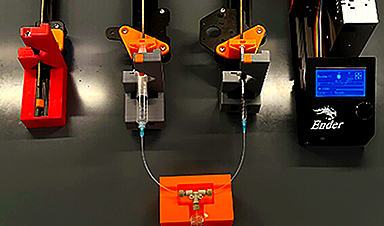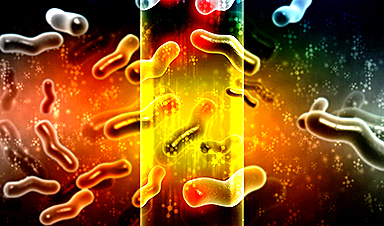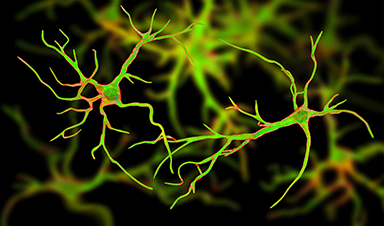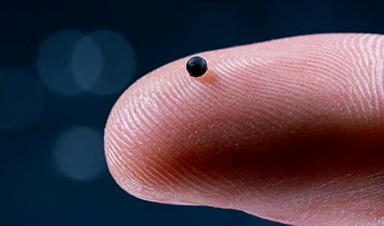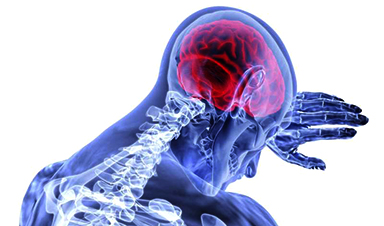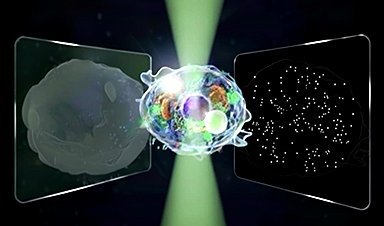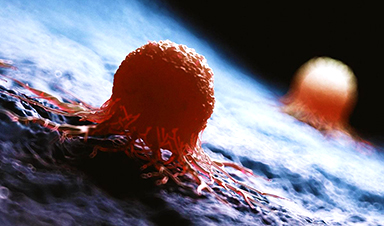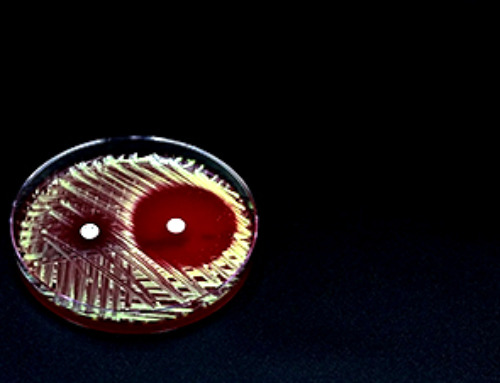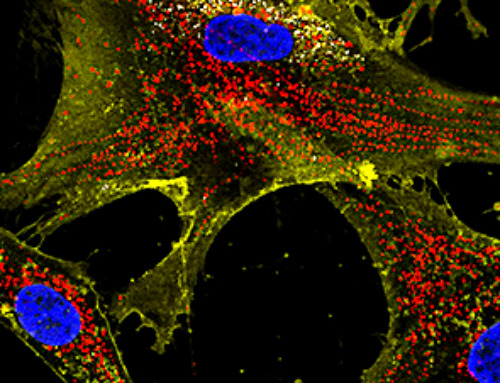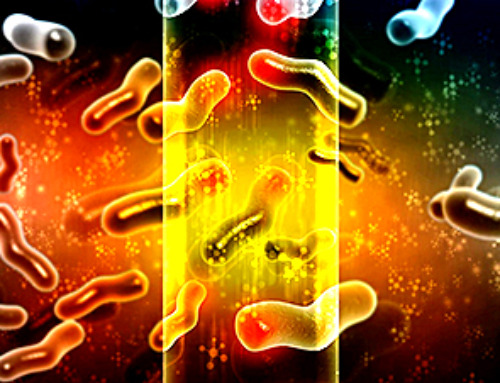Stefan Wilhelm, an associate professor in the Stephenson School of Biomedical Engineering at the University of Oklahoma, and several students in his Biomedical Nano-Engineering Lab have recently published an article in the journal Nano Letters that outlines their recent important nanomedicine advancement.
Wilhelm, with student researchers such as Hamilton Young, a senior biomedical engineering student, and Yuxin He, a biomedical engineering graduate research assistant, used 3D printer parts to mix fluid streams together containing the building blocks of nanomedicines and their payloads in a T-mixer format.
“This mixing device is essentially a T-shaped piece of tubing that forces two fluid streams to flow into each other, mixing nanomaterial and payload components together. Once mixed, the final product would exit through the other end,” Wilhelm said. “This mixing concept is used in industrial processes, so we wondered if we could make these devices as cost-efficient as possible.”
The team discovered a publication from a European research group that demonstrated that commercially available 3D printers could be reassembled into syringe pumps needed to push the fluids through the T-mixer device. Once built, they tried to produce nanomedicines with their 3D-built T-mixer.
“We were focusing on formulations that are used in the clinic, such as mRNA lipid nanoparticles, liposomes, and polymeric nanoparticles. One of the molecules we used was developed by a collaborator at OU Health Sciences to limit prostate cancer cell growth,” Wilhelm said. “We encapsulated this molecule into our nanomedicine formulations and showed that it actually stops those prostate cancer cells from growing.”

Based on this example, the team’s research has potentially broad implications for novel cancer therapies and vaccines against infectious diseases, as mRNA technology is already being used in clinical trials for personalized cancer vaccines.
“All of this mRNA technology relies on nanotechnology. mRNA molecules degrade too fast in the body to be effective without encapsulating them in nanoparticles,” Wilhelm said. “This process could open up a bright future for nanotechnology in medicine and will hopefully greatly improve health care.”
Wilhelm also foresees a future where doctors’ offices and clinics in rural communities with limited resources could use this technology to create personalized vaccines. His work with B4NANO, a partnership and outreach program with Native American tribes and communities in Oklahoma, inspires this goal.
“I could see a future situation where a patient walks into a doctor’s office with an infectious disease —possibly cancer. After a diagnosis by the doctor, a vaccine is produced at the doctor’s office in a manner similar to how a single-serve coffee maker works—you just put in your capsules, press a button, and get a personalized vaccine for that patient,” Wilhelm said. “Our goal is to develop this kind of benchtop device and then hopefully find industry partners to commercialize systems like these.”
Another goal Wilhelm has is training the next generation of biomedical engineers, like Young and He, to solve challenges in health care.
“The challenges we face in biomedical engineering require that we have a diverse team, with people coming from all different kinds of backgrounds. Everybody brings in their unique perspective, unique skill sets,” Wilhelm said. “My lab places a lot of emphasis on working with undergraduate students, even high school students, and bridging the gap from undergraduates to graduate students to postdocs. They learn from each other and learn to mentor each other.”
More information: Hamilton Young et al, Toward the Scalable, Rapid, Reproducible, and Cost-Effective Synthesis of Personalized Nanomedicines at the Point of Care, Nano Letters (2024). DOI: 10.1021/acs.nanolett.3c04171
News
Novel mRNA therapy curbs antibiotic-resistant infections in preclinical lung models
Researchers at the Icahn School of Medicine at Mount Sinai and collaborators have reported early success with a novel mRNA-based therapy designed to combat antibiotic-resistant bacteria. The findings, published in Nature Biotechnology, show that in [...]
New skin-permeable polymer delivers insulin without needles
A breakthrough zwitterionic polymer slips through the skin’s toughest barriers, carrying insulin deep into tissue and normalizing blood sugar, offering patients a painless alternative to daily injections. A recent study published in the journal Nature examines [...]
Multifunctional Nanogels: A Breakthrough in Antibacterial Strategies
Antibiotic resistance is a growing concern - from human health to crop survival. A new study successfully uses nanogels to target and almost entirely inhibit the bacteria P. Aeruginosa. Recently published in Angewandte Chemie, the study [...]
Nanoflowers rejuvenate old and damaged human cells by replacing their mitochondria
Biomedical researchers at Texas A&M University may have discovered a way to stop or even reverse the decline of cellular energy production—a finding that could have revolutionary effects across medicine. Dr. Akhilesh K. Gaharwar [...]
The Stunning New Push to Protect the Invisible 99% of Life
Scientists worldwide have joined forces to build the first-ever roadmap for conserving Earth’s vast invisible majority—microbes. Their new IUCN Specialist Group reframes conservation by elevating microbial life to the same urgency as plants and [...]
Scientists Find a Way to Help the Brain Clear Alzheimer’s Plaques Naturally
Scientists have discovered that the brain may have a built-in way to fight Alzheimer’s. By activating a protein called Sox9, researchers were able to switch on star-shaped brain cells known as astrocytes and turn them into [...]
Vision can be rebooted in adults with amblyopia, study suggests
Temporarily anesthetizing the retina briefly reverts the activity of the visual system to that observed in early development and enables growth of responses to the amblyopic eye, new research shows. In the common vision [...]
Ultrasound-activated Nanoparticles Kill Liver Cancer and Activate Immune System
A new ultrasound-guided nanotherapy wipes out liver tumors while training the immune system to keep them from coming back. The study, published in Nano Today, introduces a biodegradable nanoparticle system that combines sonodynamic therapy and cell [...]
Magnetic nanoparticles that successfully navigate complex blood vessels may be ready for clinical trials
Every year, 12 million people worldwide suffer a stroke; many die or are permanently impaired. Currently, drugs are administered to dissolve the thrombus that blocks the blood vessel. These drugs spread throughout the entire [...]
Reviving Exhausted T Cells Sparks Powerful Cancer Tumor Elimination
Scientists have discovered how tumors secretly drain the energy from T cells—the immune system’s main cancer fighters—and how blocking that process can bring them back to life. The team found that cancer cells use [...]
Very low LDL-cholesterol correlates to fewer heart problems after stroke
Brigham and Women's Hospital's TIMI Study Group reports that in patients with prior ischemic stroke, very low achieved LDL-cholesterol correlated with fewer major adverse cardiovascular events and fewer recurrent strokes, without an apparent increase [...]
“Great Unified Microscope” Reveals Hidden Micro and Nano Worlds Inside Living Cells
University of Tokyo researchers have created a powerful new microscope that captures both forward- and back-scattered light at once, letting scientists see everything from large cell structures to tiny nanoscale particles in a single shot. Researchers [...]
Breakthrough Alzheimer’s Drug Has a Hidden Problem
Researchers in Japan found that although the Alzheimer’s drug lecanemab successfully removes amyloid plaques from the brain, it does not restore the brain’s waste-clearing system within the first few months of treatment. The study suggests that [...]
Concerning New Research Reveals Colon Cancer Is Skyrocketing in Adults Under 50
Colorectal cancer is striking younger adults at alarming rates, driven by lifestyle and genetic factors. Colorectal cancer (CRC) develops when abnormal cells grow uncontrollably in the colon or rectum, forming tumors that can eventually [...]
Scientists Discover a Natural, Non-Addictive Way To Block Pain That Could Replace Opioids
Scientists have discovered that the body can naturally dull pain through its own localized “benzodiazepine-like” peptides. A groundbreaking study led by a University of Leeds scientist has unveiled new insights into how the body manages pain, [...]
GLP-1 Drugs Like Ozempic Work, but New Research Reveals a Major Catch
Three new Cochrane reviews find evidence that GLP-1 drugs lead to clinically meaningful weight loss, though industry-funded studies raise concerns. Three new reviews from Cochrane have found that GLP-1 medications can lead to significant [...]
